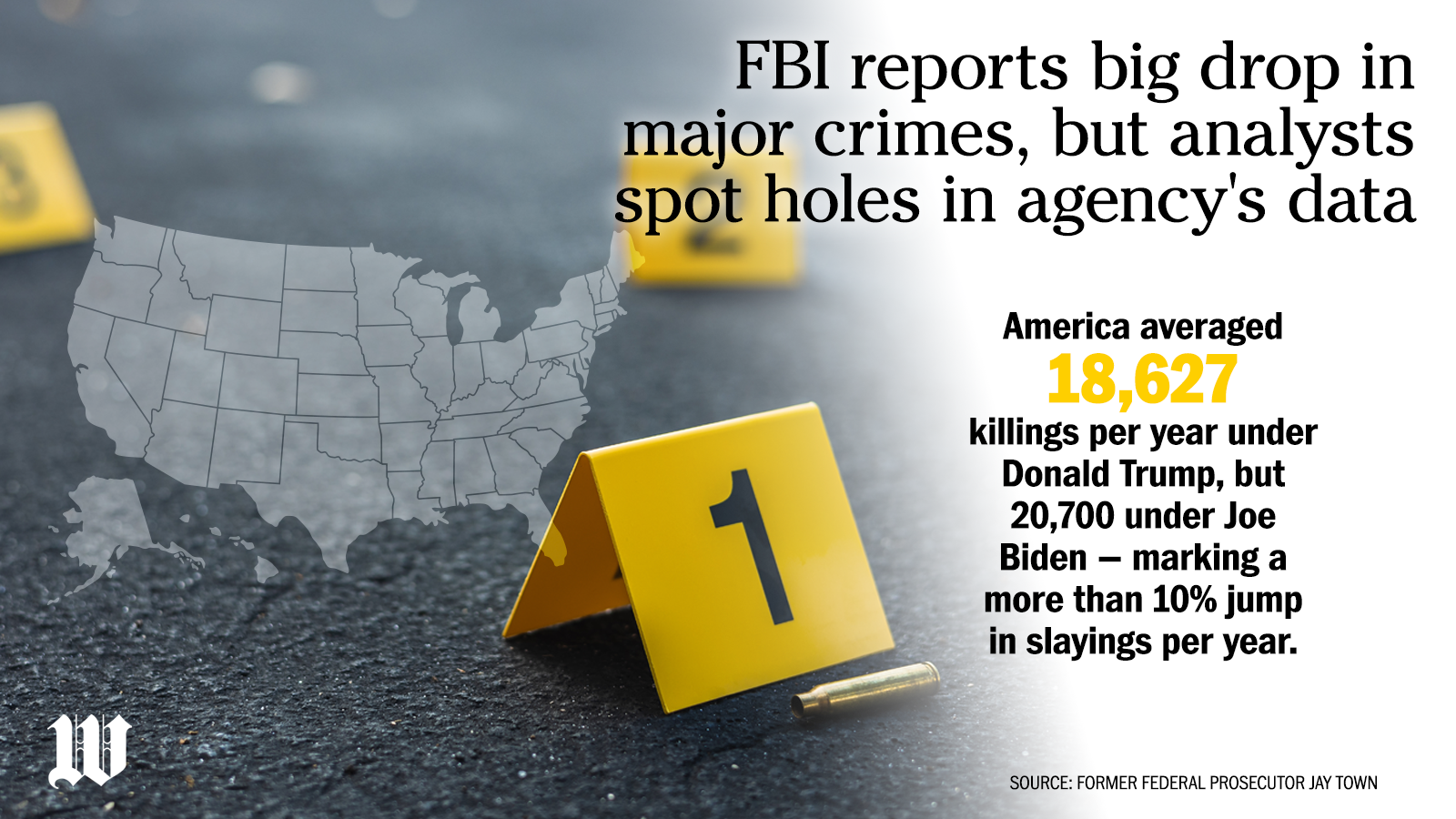The dramatic decline in crime that President Biden and other federal leaders touted this week has some analysts questioning whether a spotty data collection process is painting a misleadingly upbeat picture of public safety.
The FBI’s Quarterly Uniform Crime Report from the first three months of the year showed that violent crime fell 15% nationwide. Attorney General Merrick Garland called it a part of a continued “historic decline.”
The development is helpful to the White House, which is trying to distance itself from any charges of being soft on crime as Mr. Biden enters his likely electoral rematch against former President Donald Trump.
Law enforcement experts and researchers say the police statistics regularly submitted to the FBI — the same numbers now cited by the administration — are usually inconsistent.
Unreliable data skews the federal agency’s distillation of nationwide crime, and typically in a way that makes crime seem like less of a problem than it may be, analysts say.
“I don’t think it’s a conspiracy. It’s a rush job. It’s that they’re throwing data together,” Sean Kennedy, executive director of the Coalition for Law, Order and Safety, told The Washington Times. “Some of these data points are so wildly off that they should raise red flags.”
Mr. Kennedy said a glaring example is the quarterly report’s homicide numbers from New York City police.
The FBI counted 46 homicides in New York City from January through March, Mr. Kennedy said.
Meanwhile, the New York Police Department’s CompStat data documented 82 homicides during that period — a difference of 36.
Mr. Kennedy said the FBI’s data conveyed that the nation’s largest city almost cut homicides in half year-over-year when it wasn’t remotely true.
“They’re not only off by 50%; they’re off in the wrong direction,” the researcher said.
Homicide numbers from other organizations also challenge some of the FBI report’s most noteworthy findings.
The Major Cities Chiefs Association, a professional group for police departments with at least 1,000 officers in metropolitan areas with at least 1.5 million people, released a survey last month that said homicides fell about 17% from January through March 2023 and the first quarter of this year.
It’s a significant drop but still well below the 26% reduction in homicides documented by the FBI and applauded by Mr. Garland and Mr. Biden.
Mr. Kennedy said the issue is the government’s lack of due diligence.
He said the FBI’s research teams don’t care about getting accurate statistics from departments. The agency will also take partial data — such as eight or nine months’ worth of crime statistics to estimate annual incident data in a given city.
Even if the federal government incentivized police by offering more money or threatening to cut off grants if they didn’t send in voluntary reports, Mr. Kennedy said, it would likely do little to change department behavior.
Investing in the manpower to fill out logs for the National Incident-Based Reporting System — the federal recordkeeping system that is usually more granular than what departments require — is not something he sees local police jumping at the chance to do.
Jason Johnson, a former police officer and current president of the Law Enforcement Legal Defense Fund, seconded that assessment.
Mr. Johnson said it’s a big ask for large departments to pivot away from their normal data-gathering methods to satisfy federal information requests.
Mr. Johnson said bigger police forces will hire civilians to be statisticians so officers don’t lose their patrol duties.
Officer numbers are still down nationwide, and resources remain tight. Mr. Johnson said higher-ups are not interested in setting aside money for an employee who won’t be on the street when police work has increased in recent years.
“If they have to make a list of priorities, reducing harmful, violent crime is No. 1 priority, and making sure that they report the data in the way that the FBI wants is a much lower priority,” said Mr. Johnson, who worked as a deputy commissioner for the Baltimore Police Department from 2016 to 2018.
That said, Mr. Johnson thinks the general downward trend of crime is real.
Along with the FBI’s reported 26% decline in homicides, it also documented a 26% decline in rapes, an 18% drop in robberies and a 13% decrease in assaults.
Mr. Johnson didn’t want to comment on the agency’s numbers but said statistics such as Baltimore’s sharp decline in homicides last year and so far this year are legitimate.
On the other hand, former federal prosecutor Jay Town said withholding federal funding would motivate local police forces to improve their reports to the FBI.
He said 40% to 60% of the nation’s more than 18,000 police departments fail to send accurate data. Mr. Town said taxpayers deserve correct crime statistics to justify the billions of dollars they pay toward public safety.

The former U.S. attorney from Alabama said he isn’t convinced by Mr. Biden’s cheery spin on the FBI’s numbers.
Mr. Town wrote in The Dispatch this spring that, despite the lower rate of crimes when comparing one year to the next, the raw numbers of homicides recorded during the Biden administration far outpace what the country saw when Mr. Trump was in the White House.
The U.S. documented 22,536 homicides in 2021, 21,156 homicides in 2022 and 18,400 homicides in 2023 over the first three years Mr. Biden has been in office, according to data cited by Mr. Town.
While the same data showed 22,414 homicides in 2020 during Mr. Trump’s final year in office, the former president was in office when 18,206 homicides were recorded in 2017, 16,937 in 2018 and 16,952 in 2019.
Mr. Town said the country averaged 18,627 homicides per year under Mr. Trump, but 20,700 under Mr. Biden — marking a more than 10% jump in homicides per year with the current president.
“The last three years have been three of the most violent years in American history as far as homicides go,” said Mr. Town, who was the U.S. attorney for the Northern District of Alabama from 2017-20. “I don’t know if that’s something to celebrate.”
• Matt Delaney can be reached at mdelaney@washingtontimes.com.




Please read our comment policy before commenting.